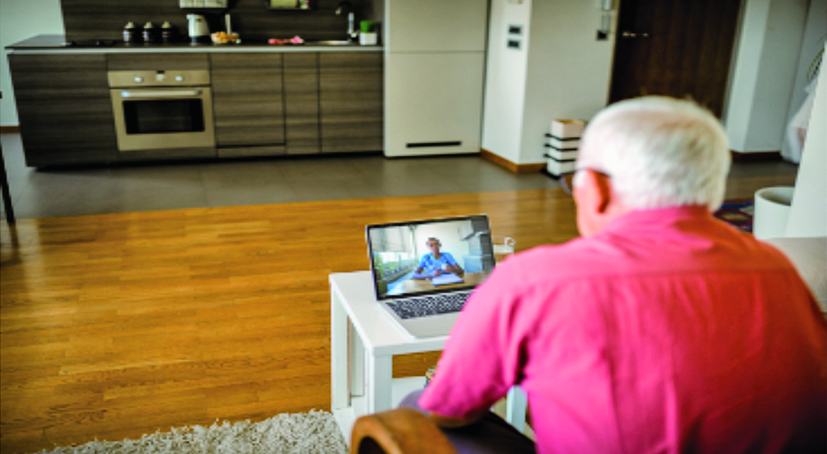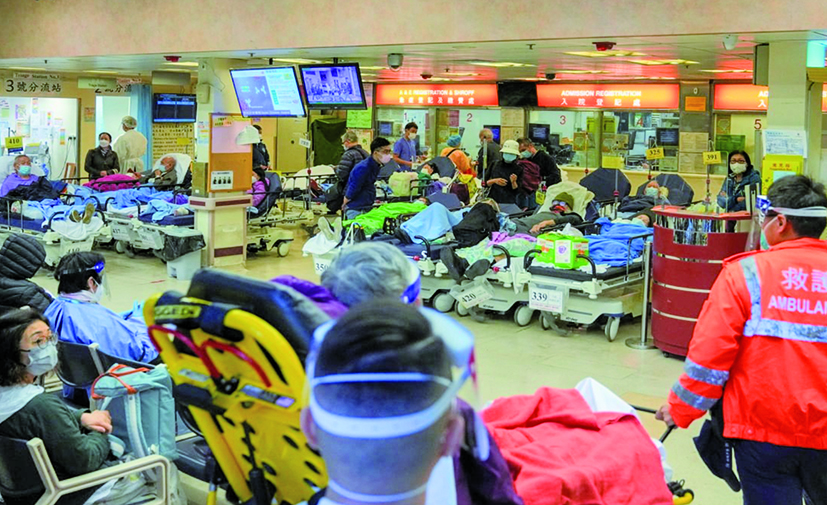
The concept of virtual wards have been around for a few years but has only recently gained more attention due to the Coronavirus disease-2019 (COVID-19) pandemic1. The COVID-19 pandemic had caused havoc in healthcare industries globally with a significant increase in demand driven by the growing and ageing population2. Moreover, due to the lack of hospital fundings, delayed patient discharges, space and staff shortage, the overwhelming stress experienced by both the patients and the clinical teams has grown over the last few years. For instance, the average waiting time for patients to be seen by a clinical team at the Accident and Emergency (A&E) during winter time has increased from 4 hours to 8 hours, and in some places, it may take up to 12 hours during the peak flu and COVID-19 seasons. Prolonged waiting time affects patient outcomes and tarnishes the healthcare reputation3-5.
The resurgence of virtual wards post-COVID-19 seems feasible since the local hospitals are now plagued by a backlog of long-waiting lists mediated by the COVID-19 pandemic. The sheer scale of the problem is overwhelming and felt globally as the waiting time for an elective surgery has increased to an average of 8% in Finland post lock-down6. Therefore, virtual wards may prove to be useful. Yet, due to insufficient real-world based studies assessing their efficacy, it is difficult to determine their role in reducing waiting times.
So, what is a virtual ward and what are the benefits of having one? The virtual ward is a hospital-led and managed clinical area. It enables the same high level of clinical investigations and treatment to be performed at patient’s own homes (Figure 1)8. Furthermore, a virtual ward utilises variable modalities that help to monitor the patient remotely with an option to provide face-to-face care when required9. Some see virtual wards as helpful tools that can free up vital resources such as occupation of hospital beds, reduce clinical team’s time, and allow a better reallocation of services10. Currently, delayed discharge for non-medical reason remains the pressing issue for the national health service (NHS) since it creates unnecessary risk for patients who may acquire infections during hospitalisation, which inadvertently prolong their hospital stay further11. Furthermore, A&E attendance and unplanned hospital admissions among frail and older adults have increased over the last few years due to the ageing global population with frequent infectious disease outbreaks12.

Figure 1. Virtual ward, or home-based treatment where healthcare professionals are available to patients for monitoring and treatment purposes7.
Over the last few years, the rebound effect on patient admission post-COVD-19 has led to an increase in waiting time, with approximately 95% of patients turning up at the A&E waited for more than the guidelines recommended 4 hours before they are seen by the clinical team, according to the NHS England13. Furthermore, the delay in discharge results in hospital bed scarcity for patients being admitted from the A&E, therefore, creating a “spill-over effect” on A&E performance13. Accordingly, to tackle this issue, the Department of Health and Social Care (DHSC) and NHS England have jointly planned to implement urgent changes within the NHS England over the next 2 years, aimed to fix England’s broken emergency care services. But how? They intended to invest around £1 billion to fund 5,000 new beds, 900 new ambulances, and to secure more clinical resources for the NHS 111 urgent care phone service by encouraging retired doctors to return to work14. What about the use of virtual wards? In England, approximately £200 million is available to NHS England to set up and develop virtual wards, with a further £250 million funds made available to trusts in 2023/202415.
What about locally? In Hong Kong, it is estimated that there is approximately 16.7% unplanned readmission, with ≥20% of these being older adults admitted as inpatients (Figure 2)17,18. The concept of virtual ward was piloted in Hong Kong in 2015 and showed a significant reduction in the number of unplanned emergency hospital admission, but the length of hospitalisation and the number of emergency attendance did not change1. In addition, a significant improvement in patient quality of life (QoL) was reported by the study which may have been attributed by the positive effect of individualised care, health education, and emotional support for the patients and their carers. Nonetheless, since the cohorts were not randomised in this study and the sample size was relatively small with limited interventions, the results may not be applicable to the real-world clinical setting1.

Figure 2. Waiting time at Accident and Emergency locally often increases due to the peak winter flu, and previous COVID-19 case surge, in addition to staff and resources shortage16
The idea of having virtual wards to reduce hospital admissions is interesting but is confounded by various limiting factors. The Royal College of Physicians of Edinburgh (RCPE) has highlighted that staff shortage may limit the virtual ward’s practicality. Furthermore, older adults, especially those with sensory or cognitive impairment, may not be able to access the technology required to manage a virtual ward9. Moreover, low health literacy is often associated with significantly less use of the internet for health information among older adults19. In addition, there are ethical issues surrounding remote monitoring, data access, and obtaining consent for treatment. In fact, apart from the above issues, it is also difficult to decide which cohorts of patients are suitable for virtual ward assessments and whether clinical staff are adequately trained to use sophisticated monitoring devices in a virtual ward setting20. Nevertheless, the concerns regarding these barriers are currently being overcome slowly thanks to the COVID-19 pandemic where there is now far less resistance to the use of the new technology by clinical staff as the remote consultation rate is approaching 90% post-COVID-19 era20.
But what about the patient safety and clinical effectiveness of a virtual ward? Virtual wards use had been trialed by Norfolk and Norwich University Hospital Foundation Trust with 852 patients provided 24 hours, 7 days a week nurse-led cover, and regular support from pharmacists and junior doctors21. Furthermore, these virtual wards were also run daily by consultant-led ward rounds and implemented scheduled virtual visits. The remote care system was used to collect continuous vital signs and the care team was alerted by nursing specialists or consultants when required. The trial concluded that patient safety was not compromised in a virtual ward setting. In addition, the staff also experienced less burnout since they were able to work from home, thereby reducing their exposure to COVID-1921. What about during emergencies? What happens to patients in a virtual ward? The patient care is escalated to the hospital for specialist care when required22. In fact, virtual wards may also help reduce the average length of hospital stay by up to 3%, reduce readmission rates by approximately 50%, and save around an estimated £1,047 per patient a day23. In view of these positive findings, it is hard to ignore the sustainability of having integrated virtual wards with concurrent hospitals. In conclusion, virtual wards may one day replace our current hospital-based approach and provide better patient-centred care with a holistic approach.
References
1. Leung et al. Clin Interv Aging 2015; 10: 413-20. 2. Kanyimo. BMJ Open Qual 2022; 11(4). 3. Al Nhdi et al. Open Access Emerg Med 2021; 13: 311-8. 4. Byrne et al. Acute Med 2018; 17(3): 130-6. 5. Nyce et al. J Patient Exp 2021; 8: 23743735211011404. 6. Uimonen et al. PLoS One 2021; 16(7): e0253875. 7. NHS, Virtual wards. 16/11/2022 2022. https://transform.england.nhs.uk/information-governance/guidance/virtual-wards/ (accessed 10/05/2023 2023). 8. Milne-Ives et al. JMIR Res Protoc 2022; 11(2): e33812. 9. Norman et al. Age Ageing 2023; 52(1). 10. Shah et al. BMC Family Practice 2021; 22(1): 248. 11. Ego et al. Ann Med Surg (Lond) 2022; 82: 104680. 12. Van den Heede et al. Eur Geriatr Med 2019; 10(5): 697-705. 13. Friebel et al. Health Policy 2020; 124(11): 1182-91. 14. Iacobucci. BMJ 2023; 380: p239. 15. Society BG. Bringing hospital care home: Virtual Wards and Hospital at Home for older people. 17/08/2022 2022. 16. SCMP. Coronavirus: Hong Kong hospitals, clinics battle surge in Covid and flu cases as Panadol shortages frustrate residents. 26/12/2022 2022. 17. Tsui et al. Health Informatics J 2015; 21(1): 46-56. 18. Wong et al. BMC Health Serv Res 2011; 11: 149. 19. Levy et al. J Gen Intern Med 2015; 30(3): 284-9. 20. Irving et al. Br J Gen Pract 2021; 71(710): 425. 21. Wells et al. Br J Nurs 2022; 31(20): 1040-4. 22. Ferry et al. J Med Internet Res 2021; 23(2): e25518. 23. Swift et al. Br J Health Man 2021; 28(1): 7-15.





